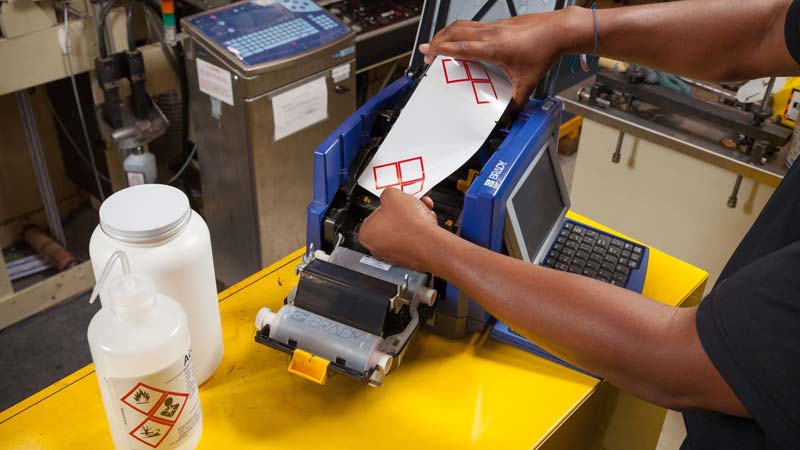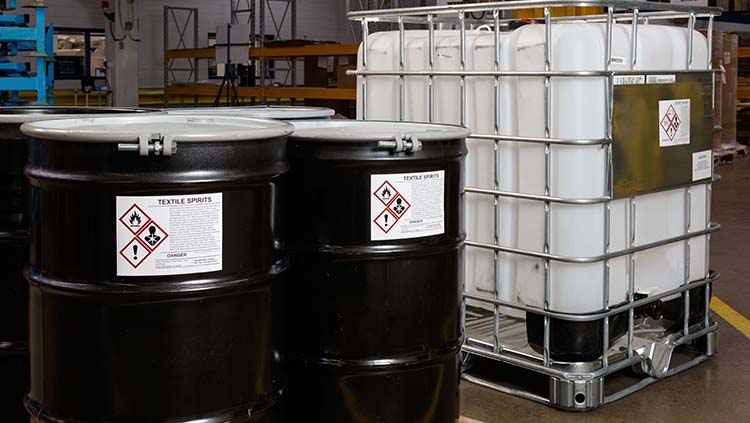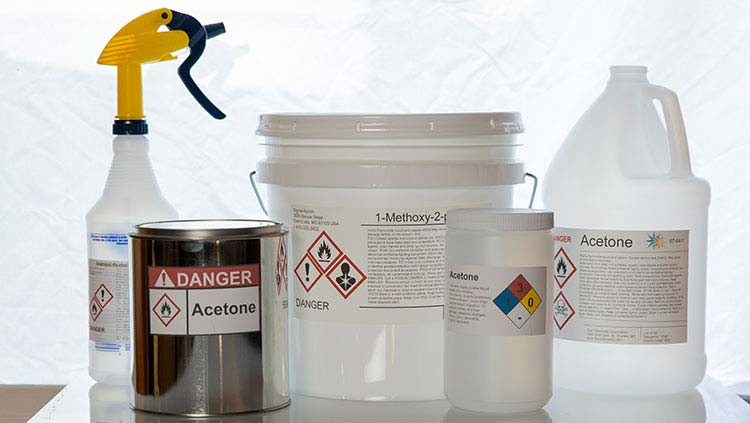Labels for Safety, Visuals and Facility ID Desktop Printers
Labels for Product, Wire and Lab ID Benchtop Printers
Labels for Safety, Visuals and Facility ID Desktop Printers
Labels for Product, Wire and Lab ID Benchtop Printers
Safety and Facility ID Desktop Printers
Product, Wire and Lab ID Benchtop Printers
Barcode Scanners and RFID Readers
PaintStripe Floor Marking Stencils
Valve Lockouts & Hose Lockouts
Group Lock Boxes & Permit Control
Pipe Marker Accessories & Mounting Brackets
Maintenance and Production Tags
Calculators and Assessment Tools
Product Finders and Data Sheets
The Occupational Safety and Health Administration (OSHA) sets guidelines for companies, managers and manufacturers to keep the American workforce safe. One key part of OSHA compliance is clear communication about hazardous materials via the HazCom Standard.
As part of this standard, manufacturers of potentially harmful materials need to clearly label its products so consumers can handle them carefully. This ranges from advising consumers to wear gloves when using household cleaners to alerting workers to the need for safety goggles when handling toxic substances.
Learn more about the hazard communication standard (HCS) and how its labeling requirements are an integral part of many companies safety initiatives.
The hazard communication standard requires companies to add labels to potentially harmful substances. These are also known as HazCom labels and they serve two purposes:
Hazard communication labels should be found on most products that contain toxic substances or flammable chemicals, among other hazards, and they consist of six main elements including HazCom pictograms.

HazCom labels are essential for workplace safety. They prevent employees from handling various chemical elements in ways that can harm themselves, their coworkers and the workplace itself. Some flammable and reactive substances can ignite at low temperatures, potentially endangering your entire organization.
The HCS is aligned with other internationally-recognized systems. For example, the Globally Harmonized System (GHS) is an international labeling guide created by the United Nations (UN). It uses graphics to alert users that a substance is dangerous, which allows for easy communication across all languages. The HazCom labels also use GHS indicators to clearly alert users to the potential dangers of various substances no matter where they are in the world. GHS and HCS are truly universal safe labeling standards.
At first glance, the HazCom labels are colorful and might seem basic. However, these labels provide a lot of information to users so they can stay safe when handling dangerous substances. Learn how to read these labels and provide accurate training on the content to your team members.
The first step for manufacturers is to determine if a substance is potentially hazardous. From there, the substance will need to be labeled clearly using HCS guidelines. There are three different ways that hazards are classified, as you can see in most hazmat labels:

Health: This means the chemical is toxic to humans and harmful if handled or digested. These hazards often require people to wear eye protection, gloves and a face mask to avoid coming into contact with the substance or inhaling its fumes.

Flammability: This covers how likely a chemical is to ignite or combust. Substances that ignite in lower temperatures are considered more flammable and dangerous to handle.

Instability: This is also known as reactivity and refers to the likelihood of a substance exploding.
Some hazards might be harmful to humans but not flammable. This is why the HazCom labels need to distinctly highlight why a substance is considered dangerous.
The next step when working with HazCom labels is to indicate everything that users need to know when handling the substance. For GHS requirements, there are six elements that need to be on every label.
You can also review OSHA documents that detail these six elements to make sure each level includes them.
Each potentially dangerous substance created by a manufacturer needs a clear HazCom label. However, these products also come with safety data sheets (SDS). These sheets provide greater detail into the nature of the product and how to respond if it was handled incorrectly.
Employees should have access to the SDS of various chemicals they need to handle. While GHS labeling is useful for understanding the risks of handling substances at a glance, these sheets provide additional information that is valuable to your team members.
Never assume that your employees know how to read HazCom labels and can access the safety sheets. Introduce these labels in your onboarding process and test employees on their ability to understand them. You can also retrain employees periodically to make sure they are staying safe.
There are multiple economic incentives for training your team on hazardous materials safety. You can reduce the number of workplace accidents that cause property damage to your facilities. Reducing workplace accidents can also lower employee medical expenses you need to cover and worker’s compensation costs. This could also reduce absenteeism because of accidents, making staffing easier.

Primary Containers

Secondary Containers
In most workplaces, employees use a mixture of primary and secondary containers to handle chemicals. A primary container is often used for shipping or moving, while a secondary container is meant for workplace use.
For example, a company might buy a large container of cleaning solution that is then divided into multiple spray bottles. The individual spray bottles are secondary containers. In a laboratory setting, a secondary container could be a beaker or test tube because a researcher only needs a small amount of the solution.
Primary containers should come with HazCom labels attached because these are usually shipped directly from manufacturers. However, if you use secondary containers in your organization, you will need to affix these labels yourself. It’s still important for employees to know the risks of the substances they are handling, even in small quantities. OSHA has guidelines for labeling secondary containers to stay compliant and safe.
While it is up to the manufacturer to keep up with labeling guidelines on its products, you can still make sure that your employees have a safe place to work — especially if they regularly need to handle dangerous substances. Here are a few best practices to keep in mind.
Workplace safety is a process that employees practice every day. The same goes for hazardous materials labeling and management. Every time an employee picks up a potentially dangerous substance, they need to have the right protection, knowledge and training to keep everyone safe.